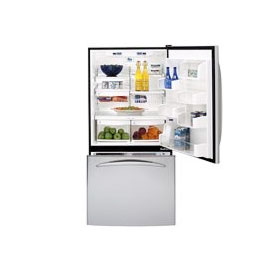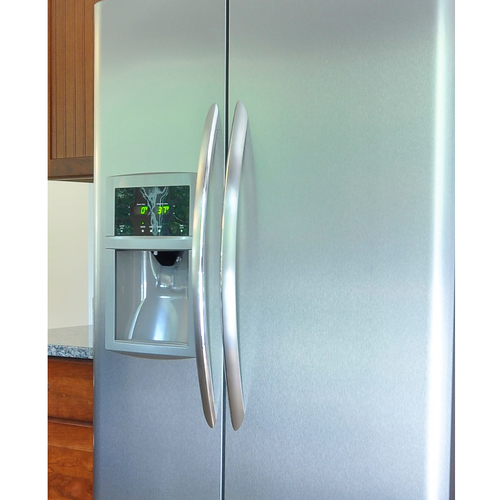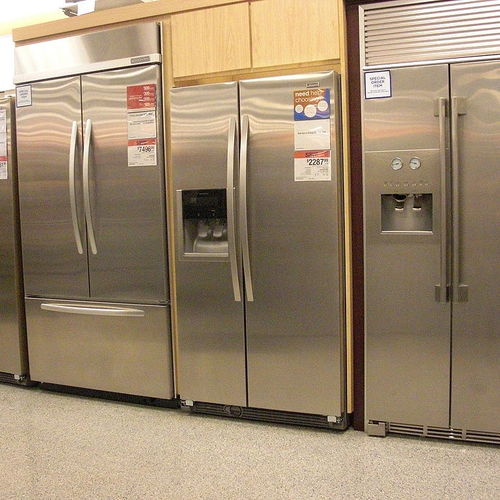
In a typical home, the refrigerator accounts for about 8% of the total annual energy expense, according to 2005 data from the U.S. Department of Energy. While this energy consumption for food storage is significant, it’s far less than it was a few decades ago. In the mid-1970s, an average new refrigerator used about 1,800 kilowatt-hours (kWh) per year, making it the single most expensive energy load in many homes.
Today, even though refrigerators are significantly larger than in the mid-70s, the energy use has dropped dramatically, due to more efficient compressors, improved insulation, and other features.
Refrigerators sold today must meet minimum energy performance standards, which are set by the U.S. Department of Energy (DOE). These standards are based on a complicated formula that factors in size, configuration, and features. The maximum electricity consumption for a typical 19-cubic-foot top-freezer model works out to about 500 kWh/year. With side-by-side refrigerator-freezers that maximum consumption is a lot higher. Energy Star refrigerators use at least 20% less energy than the federal limit. Both the federal energy performance standards and Energy Star requirements have been tightened periodically since those programs were first launched.
So, if you have an old fridge, chances are pretty good that it’s an energy hog and you could save a lot of energy by replacing it. To find out how much electricity your existing fridge is using, buy or borrow an electricity monitor (see last week’s column), plug your fridge into it for a week or two, then calculate the annual usage.
If you decide to buy a new fridge, here are some tips:
- Use the yellow EnergyGuide labels to compare one model to another in the appliance store. These guides show the annual electricity consumption based on standardized testing; as with automobile fuel economy ratings, your actual energy use may vary.
-
Choose an Energy Star-certified refrigerator. The current Energy Star standard for refrigerators requires 20% lower electricity use than the federal maximum, so if you see the Energy Star logo on a fridge, you can be confident that it’s a pretty energy-efficient model.
- Manual defrost saves energy. The most energy-efficient refrigerators are manual-defrost models, but these are available primarily with small, low-end products aimed at the rental-apartment market or with specialized (expensive) models designed for “off-grid” homes powered by solar or wind energy.
- Choose a top-freezer or bottom-freezer model over a side-by-side refrigerator-freezer. Side-by-side models use significantly more energy because of their larger size and larger door area. If you need additional freezer space, consider a chest freezer. Be aware that because the federal standards (and Energy Star certifications) vary by configuration, an Energy Star-certified side-by-side model may use significantly more energy than a non-Energy Star top-freezer model.
- Don’t buy a larger refrigerator than you need. Larger models usually use more energy than smaller ones—though this isn’t always the case (which is why it’s important to compare the yellow EnergyGuide labels)—see mini-fridges below.
- Avoid mini-fridges. Those small, under-counter refrigerators, even Energy Star-certified models, use significantly more electricity per cubic foot of capacity than full-size refrigerators. Under the federal standards, a 5-cubic-foot, under-counter refrigerator may use as much electricity as an 18-cubic-foot refrigerator-only model, yet it holds less than a third as much food! I’m not sure why the performance is so bad with mini-fridges; it has partly to do with the greater surface-to-volume ratio.
- Avoid through-the-door ice and water dispensers unless you really need these features, as they can increase electricity usage by 10 to 20%.
- Recycle the old one. If you’re getting a new fridge, avoid the temptation to keep the older one in your garage or basement to hold a few six-packs of beer or soda.
- Install the fridge away from heat sources. The waste heat from a kitchen range will make the refrigerator’s compressor work harder and thus use more electricity.
- Operate the fridge for energy savings. Some refrigerators have electric heating elements to keep the outer surface warm enough that condensation won’t occur. This feature wastes energy—both through the direct electricity use and by making the compressor work harder to keep the interior cold. If there’s an energy-saving switch on your refrigerator keep it set to the energy-saver mode unless condensation becomes a problem.
Weekly Newsletter
Get building science and energy efficiency advice, plus special offers, in your inbox.















One Comment
So that's why my refrigerator
So that's why my refrigerator is always warm, it helps preventing condensation. I thought it is strange but it's good to know that i can switch it on energy saving and save money that way. I have to check if it has that setting first, it has been several years since i bought it and i never bothered to try them all. Even if it broke down once and i had to find some parts to fix it, i wouldn't change it, it was one of the best energy efficient fridge when i got it so i think it's ok to keep it for another few years.
Log in or create an account to post a comment.
Sign up Log in